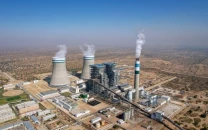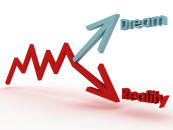Pakistan should shift to efficiency-driven economy
Will be required to move up value addition, quality and technological ladder

Representational image. PHOTO: REUTERS
Likewise, the International Monetary Fund (IMF) categorises countries into emerging or developing and advanced economies. In the UN system, nations are classified as least developed, developing and developed countries. A lesser known, but a very useful, way to classify countries is employed by the World Economic Forum, which on the basis of level of competitiveness sets up a three-fold classification: factor-driven, efficiency-driven and innovation-driven economies.
The factor-driven economies compete on the basis of labour, mainly unskilled, and natural resources while enterprises in these countries compete on the basis of low wages and produce low-priced products.
The efficiency-driven economies, on the other hand, compete on the basis of product quality and efficient production processes. The innovation-driven economies are knowledge-based and excel in introducing new products, processes and technologies.
Pakistan lies in the factor-driven category
Pakistan is classified as a factor-driven economy and rightly so. The country is essentially a producer of basic (wheat, cotton, fruits and vegetables) and processed (rice and sugar) agricultural products and labour-intensive, agro-based manufactures (textiles and leather products).
Domestic firms, by and large, thrive on the basis of low prices, which are underpinned not by efficient production processes, but by low wages and government subsidies. Since consumer protection and welfare is given a short-shrift, product quality is generally low.
Lack of quality is also a major impediment to the development of local brands as branding implies a long-term commitment to product quality. That is the reason we hardly see any Pakistani brand in the international market. Even our major exporters are content with working as sub-contractors for the world’s major manufacturers and retail outlets.
As a result, the country mainly exports agricultural products and low-priced agro-based manufactures, which in most cases are sold to the low end of the market, while it imports machinery and capital equipment in addition to petroleum products. In 2017-18, for example, the share of primary products and semi-manufactured products in the country’s total exports of $23.22 billion was $21.81 billion or 93.92%.
On the other hand, the same year, the share of vehicles, machinery and capital equipment in the country’s total non-energy related imports of $46.25 billion was $15.94 billion or 34.46%, according to the PBS data.
The status of being a factor-driven economy has been behind two balance of payments-related problems. One is the trade deficit, which reached $37.67 billion at the end of fiscal year 2017-18 while the other is adverse terms of trade as prices of primary, non-oil products are generally much lower than that of machinery and equipment.
The adverse terms of trade means that in order to import even a small quantity of high value-added products we need to export a much larger quantity of low valued-added goods.
Country should go for efficiency
Pakistan, therefore, needs to graduate from a factor-driven to an efficiency-driven economy. It is not necessary for an efficiency-driven economy to produce hi-tech, sophisticated products. What is necessary is to gradually move up the value addition, quality and technological content ladder and diversify the product portfolio.
This will require material changes in resource allocation, production mix, manufacturing techniques, management style and the relevant institutional environment.
Presence of efficient product markets is one of the primary conditions for an efficiency-driven economy. Product markets are efficient when the right mix of goods and services is produced and traded at minimum costs, is consistent with product quality and reliability, and when efficiency is rewarded and inefficiency penalised.
Through a judicious mix of fiscal, trade, industrial and competition policies, product market efficiency can be enhanced. For example, subsidies and tariff protection have been an important instrument of industrialisation all over the world.
The key question is not whether to protect and subsidise the domestic industry, but which industries ought to be the beneficiaries of tariff protection and government support.
Not all industries can be, and should be, protected. Even after seven decades, if an industry still needs tariff protection from foreign competition or subsidies to compete in foreign markets, there is no doubt that the government has bet on the wrong horse. Protection, therefore, should be provided to only those industries which have a potential to grow and not to declining or stagnant industries. Besides, protection should be linked to performance.
Likewise, an effective competition regime is necessary for curbing anti-competitive practices. For instance, several important industries in Pakistan such as ghee, sugar and cement are characterised by cartels, which often collude to cut back on output, fix prices, divide markets, contrive shortages or supply sub-standard goods.
Competition can also be enhanced by easing the barriers to entry for new firms through simplification of the incorporation process of companies. Labour-market efficiency is an adjunct to product-market efficiency. Efficient labour markets are characterised by high productivity of labour and a match between labour skills and jobs.
In Pakistan, low wages are widely regarded as the key to competitiveness. The flip side of wages is productivity. If wages are kept low, labour productivity will be difficult to shore up. The government can promote labour-market efficiency by investing substantially in human resources development, ensuring compliance with labour laws and standards, and encouraging and subsidising the corporate sector in skill development.
Willingness to take risk, innovate
The sage of advanced economies shows that the graduation from a factor-driven to efficiency- and then to an innovation-driven economy was made possible by the rise of dynamic entrepreneurship. Entrepreneurship does not mean having a lot of capital at an enterprise’s disposal as several success stories of the 21st century started with a modest capital. Instead, it entails a willingness to take risk, innovate and venture into new products, processes or new ways of managing the business.
Instead of promoting entrepreneurship and rewarding innovation, successive governments in Pakistan have focused on giving unconditional cash support to the traditional sectors, sticking to the traditional ways of doing business.
Such support stifled both entrepreneurship and growth in the productive capacity of the economy, on which its long-term growth hinges. On account of deficiency of dynamic entrepreneurship, we are producing nearly the same product mix, in substantially the same way, as we were doing five decades ago.
As institutional economists put it, production is not merely a mechanical but a social process as well. Hence, one of the crucial conditions for the growth of entrepreneurship is the presence of supportive social climate or institutions, which provide a predictable, fair and supportive environment for economic growth. The institutions may stifle or promote growth and investment, may reward or penalise efficiency and productivity, may apportion costs and benefits judiciously or arbitrarily, and may discourage or encourage predatory economic behaviour.
In Pakistan, the framework of economic governance is in place, however, the independence and effectiveness of the institutions has not been up to the mark.
The writer is an Islamabad-based columnist
Published in The Express Tribune, November 1st, 2018.
Like Business on Facebook, follow @TribuneBiz on Twitter to stay informed and join in the conversation.



















COMMENTS
Comments are moderated and generally will be posted if they are on-topic and not abusive.
For more information, please see our Comments FAQ